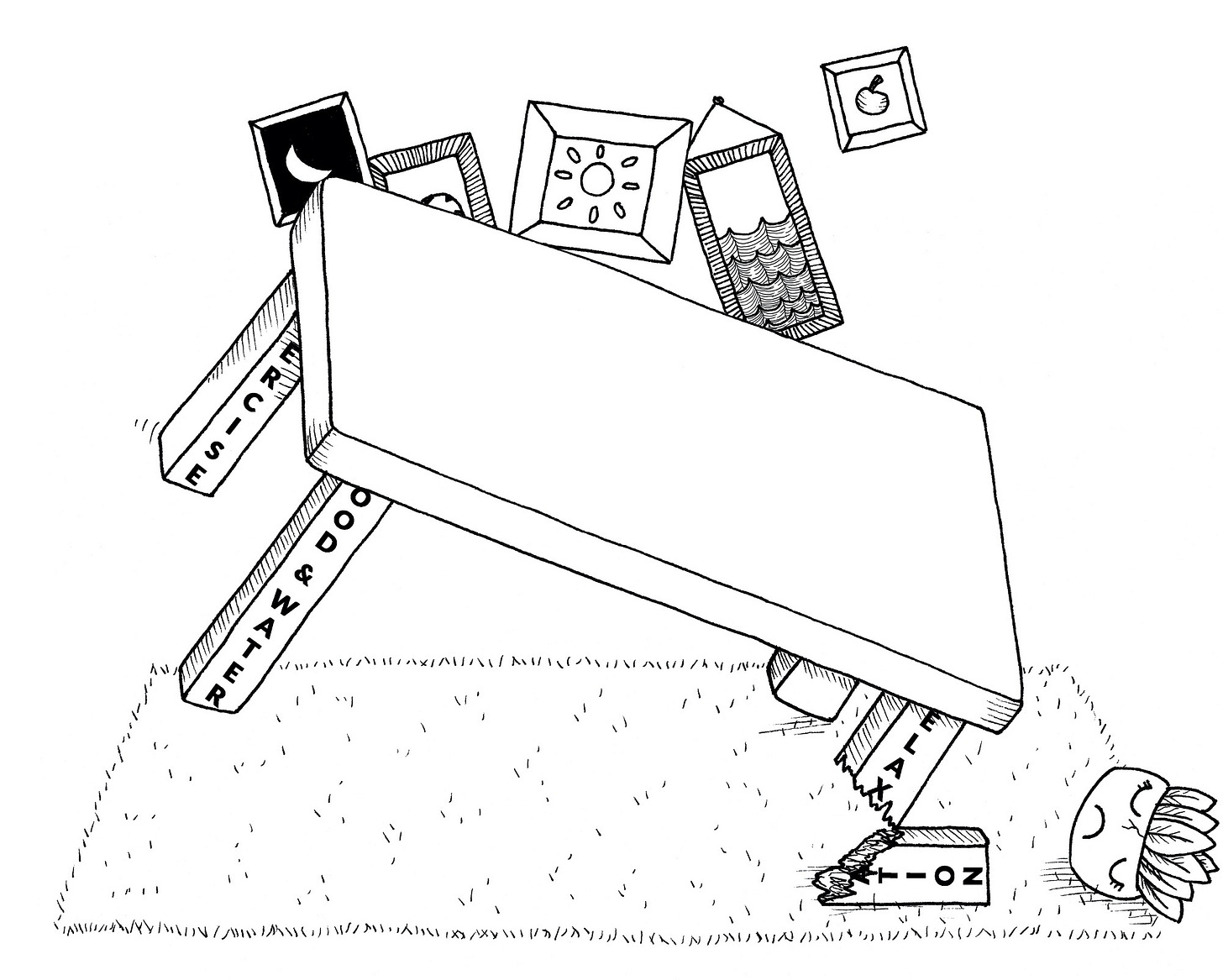Almost exactly a year ago I wrote HERE about recharging your body battery. Do have a quick read to remind yourself of that. Or even a slow read, because slow reads are usually better than quick reads for something that contains a lot of information and ideas.
Today, I’m giving you a slightly different, though entirely complementary method of maintaining good physical and mental health.

The Table of Wellbeing is an image I use to describe the things we need to keep an eye on to maintain health, physical and mental. The Table has four legs:
Food+water - nutrition, providing energy and all the nutrients necessary for best working of our physical bodies and our mental processes
Exercise and activity - boosting physical strength, mood/self-esteem and sleep
Sleep - essential for every aspect of our bodies and minds
Relaxation - allowing physical restoration, processing of learning, enhanced creativity and optimal cognition
The point about a four-legged table is that if you have three strong legs but one weak one, when it breaks, the table doesn’t slightly collapse: it falls over completely. So we need to keep ALL the legs strong. All the time. And we need to keep tabs on how they are.
I asked the artist, Katherine Lynas, to show the “relaxation” leg breaking because I felt that this is the one many people most often ignore or don’t view as essential. Particularly if they are high-achieving, ambitious, perfectionist types and particularly when they have high pressure situations coming up, such as exams, auditions or performances.
However, I increasingly believe that the other one most often *ignored is sleep. So I wrote the book The Awesome Power of Sleep and also have a lot of free materials on sleep, such as HERE.
*Or, perhaps it’s not so much ignored as regarded as something that is a) difficult or impossible to change and b) not quite important enough to spend much effort on. (Both wrong!)
How to balance your legs
Think carefully about which leg(s) might be your weakest, which might benefit most from strengthening efforts.
Also look at what you already do for EACH leg and be prepared to add something to EACH.
Then, do a bit of research into what are the up-to-date recommendations for each.
And now make ONE change in your approach to each leg. Don’t try to change all your behaviours and habits in one go. The late Michael Moseley’s Just One Thing is a good model.
When you’ve embedded one thing, do another.
Keep alert to changes in your needs, for example as you go through times of stress or illness or whatever.
Choose the right advice
Make sure you’re following GOOD and RECENT advice, not either old-fashioned or weird AI-generated stuff on the internet. If you’re on Instagram (or wherever) make sure you’re following people with relevant knowledge and experience and a credible track record. Be extra cautious when they are selling things - nothing wrong with selling things but still be extra cautious about the advice.
Top tips for each leg
Obviously, you have to work with your life: your age, daily pressures, commitments and budget. But there is always something we can do differently if we want to.
Food and water:
The more different plant foods you can eat the better. My husband and I made changes to our already excellent diet recently and we now eat around 50 different plants foods a week, easily. And I do mean easily - it’s no chore once you realise what the options are with seeds, nuts, grains etc. I now don’t keep an inventory - it’s second nature and delicious and it makes us feel better.
Most people don’t eat enough protein - and too many people think “meat” as soon as you say “protein”. I think “chicken/fish/eggs and nuts/seeds/wholegrains/pulses/beans etc”. ALL living things (including plants) contain protein! Our lunches now properly fill us up and we just don’t seem to want sweet things any more. I’ve even stopped wanting my evening two squares of chocolate - usually.
Exercise and activity:
Walking/step-counting are honestly not enough! We also need activity to raise heart rate sometimes AND we need to strengthen all our muscles. So we need different things and certainly to include weight/resistance exercises. This is especially true as you get past 55 or so.
Do it in the morning if you can and do it outside if you can. This will set you up for the day and help your sleep, too.
Sleep:
Your evening wind-down routine is crucial - and can usually be changed/improved. I have lots of advice about this:
In the two hours before bed, make sure you avoid what I call sleep negatives and instead include plenty of sleep positives (see below)
Relaxation:
First, build it into EVERY day. However busy you are - and in fact when you are super-busy it becomes even more super-important - there needs to be the question “What have I done to relax today?”
Distinguish between relaxation actions that genuinely lower heart rate (such a having a bath or just sitting quietly in the sun) and those that help your stress levels by creating a distraction (such as watching a film or reading an exciting book.)
How is your Table of Wellbeing? And what could you do today to make each leg stronger?




